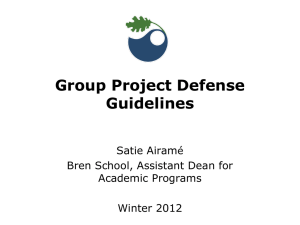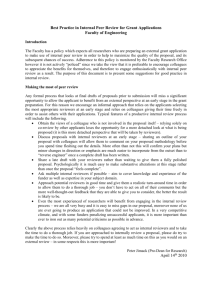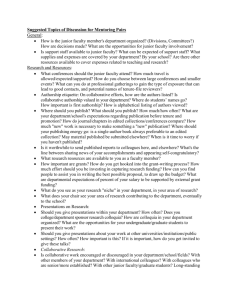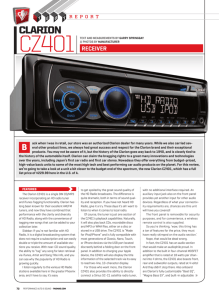Guidelines and Instructions for Graduate Research Application A
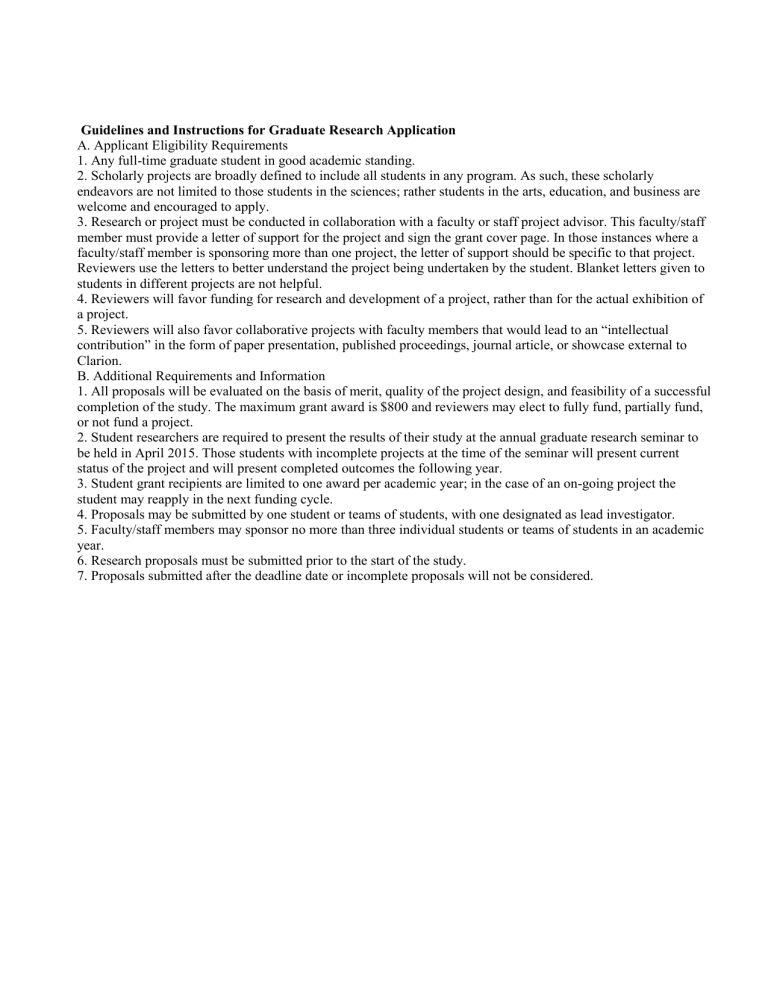
Guidelines and Instructions for Graduate Research Application
A. Applicant Eligibility Requirements
1. Any full-time graduate student in good academic standing.
2. Scholarly projects are broadly defined to include all students in any program. As such, these scholarly endeavors are not limited to those students in the sciences; rather students in the arts, education, and business are welcome and encouraged to apply.
3. Research or project must be conducted in collaboration with a faculty or staff project advisor. This faculty/staff member must provide a letter of support for the project and sign the grant cover page. In those instances where a faculty/staff member is sponsoring more than one project, the letter of support should be specific to that project.
Reviewers use the letters to better understand the project being undertaken by the student. Blanket letters given to students in different projects are not helpful.
4. Reviewers will favor funding for research and development of a project, rather than for the actual exhibition of a project.
5. Reviewers will also favor collaborative projects with faculty members that would lead to an “intellectual contribution” in the form of paper presentation, published proceedings, journal article, or showcase external to
Clarion.
B. Additional Requirements and Information
1. All proposals will be evaluated on the basis of merit, quality of the project design, and feasibility of a successful completion of the study. The maximum grant award is $800 and reviewers may elect to fully fund, partially fund, or not fund a project.
2. Student researchers are required to present the results of their study at the annual graduate research seminar to be held in April 2015. Those students with incomplete projects at the time of the seminar will present current status of the project and will present completed outcomes the following year.
3. Student grant recipients are limited to one award per academic year; in the case of an on-going project the student may reapply in the next funding cycle.
4. Proposals may be submitted by one student or teams of students, with one designated as lead investigator.
5. Faculty/staff members may sponsor no more than three individual students or teams of students in an academic year.
6. Research proposals must be submitted prior to the start of the study.
7. Proposals submitted after the deadline date or incomplete proposals will not be considered.
C. Preparation of the Grant Application
1. Complete the grant application cover sheet with attached, signed, support letter from faculty/staff project advisor. This letter should address the significance of the project to the student as well as the qualifications of the student to complete the study.
2. Introduction (1 page or less; 11 font or higher) a. This section should contain enough background information that reviewers can understand the significance of the project. Remember that reviewers come from a variety of disciplines which means that the proposal must be clearly understood by someone outside of your field of study – so write appropriately. b. Literature relevant to the proposed research should be briefly reviewed and cited. c. Clearly state the objective and/or purpose of your proposed research.
3. Materials and Methods (1 page or less; 11 font or higher) a. Methods must be described in sufficient detail that the reviewer can easily follow the procedures and determine if they have been thoughtfully designed and supported by the faculty in the academic field. For example, when appropriate, controls to be used in experiments should be described and statistical tests used in data analyses should be outlined. b. A time-line for the completion of the project must be included. c. Any literature appropriate for an understanding of the methods should be cited. d. Materials and equipment needed to successfully complete the project should be included in this section.
4. References a. This section must include all of the literature citations mentioned in the sections above. The format of references will vary from one discipline to another, but they should be consistent. Reference citations cannot be entirely web-based and must include some citations from journals and books.
5. Budget a. Use the format provided and include the cost of each item. Allowable expenditures include: funds to defray the cost of consumable supplies, specialized services, and equipment which is not readily available. Travel costs incurred in the conducting of the study are permitted as are travel costs to support attendance at professional meetings where results of the study are presented. Ineligible expenditures include: salaries, stipends, or consulting fees. Equipment and supplies which can reasonably be obtained in academic departments will not be supported. b. Provide a brief justification for the items purchased or for the expense. c. Include any additional sources of funding for the project. Reviewers like to see that in large, expensive projects additional funding has been secured or is being sought. d. All materials or equipment purchased will become the property of Clarion University at the completion of the project. e. Purchasing of materials must follow Clarion University purchasing procedures.
6. Addendum (2 pages or less; 11 font or higher) a. Provide a brief letter of your career objectives and how the graduate research will further your achievement of these goals. Include in this letter your accomplishments to date.
Also attach a resume of your collegiate career to date.
Graduate Research Proposal Checklist
Due Date: November 14, 2014
Required:
A. Materials Submitted
1. Full time graduate student
2. Letter of support from faculty advisor or staff support
3. Students resume attached
4. Advisor’s signature on the Grant Proposal Form ____
5. One copy of the proposal (including grant form & budget) submitted ____
6. Intellectual contribution described as: presentation published proceeding article other ____
B. Merit
1. Quality of design
2. Feasibility of completion
C. Introduction
1. Significance
2. Lit review adequate
3. Clarity of objectives
D. Materials/Methods
1. Clarity of Methods
2. Timeline included
3. Support for methods cited
4. Materials/Equipment
E. References
1. Includes all narrative citations
2. Consistent style
3. Includes non-online sources
F. Budget
Allowable Addressed and Justified a. Consumables b. Specialized Services c. Equipment d. Travel e. Data collection f. Presentation
Not Allowed g. Salaries or Stipends h. Available Supplies/Equipment
Budget exceeds $800
If yes,
Additional sources of funding are identified
Additional sources of funding are secured
Addendum included
Send one of the following ways:

